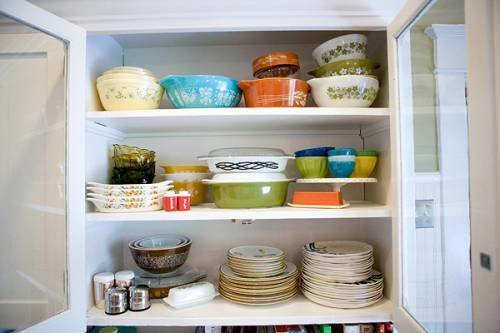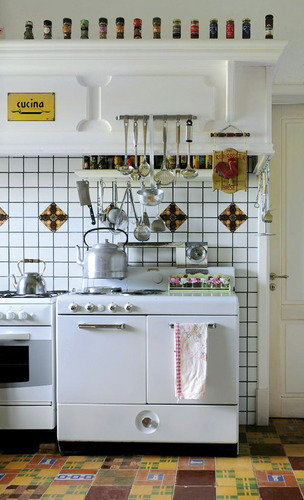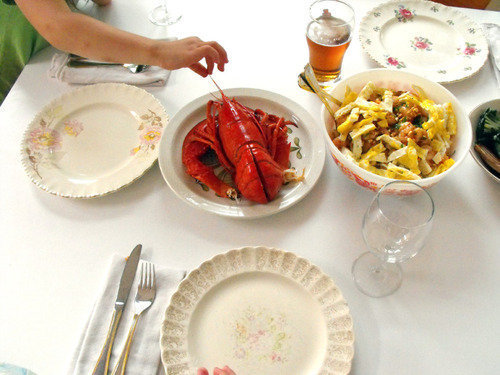Mismatched home decor is all the rage these days — from mismatched dishware to dining chairs. We've even seen mismatched couch cushions we liked.
Of course, mismatching is delicate business. It's not always as simple as tossing a bunch of stuff that doesn't match together and hoping for the best. That's something only really amazing decorators can pull off, and there's probably more to it than it seems.
However, if you follow these six basic rules of mismatching, you, too, can pull of the mismatched trend in your home.
When it comes to mismatching pieces in your home decor, the general rule of thumb is to find some small thread of matchy-matchy between the items; match the type of material, the color palette, the design, the period, etc. In other words, take a moment to match your mismatches just a little.
Here are six rules to help guide you.
The 6 Basic Rules of Mismatching
1. Stick to a Single Color
Make your mismatched decorating cohesive by sticking to a single color. It can also work to pick a complementary color palette to work within.
(Shown above) This lovely dining room collection has at least five different chair styles around it. The decorator stuck to white, which makes for a kindred, contemporary look.

Brian over at Decor Demon coordinated his mismatched chair finds with high-gloss red spray paint and a black and white mod fabric for the cushions. Looks great!
2. Pair Similar Materials
Pick wood, metal, plastic, or fabric. Just try to condense your material choices down to one or two.

Love this collection of wood and black dining chairs in four different designs. Creates a stylish and modern dining area.

Amy Fursteneau put together a mix of metal chairs around her table.

Love the mismatched painted wooden chairs — from bright yellow to bright white — in the home of Tara Thayer.
3. Play With Pieces From the Same Period
Home decor from a single period or design era tend to work together without even trying.

These mismatched Edo Napkins ($48.50) from Shopsin's General Store are inspired by the layers of patterns in Edo period clothing. What a pretty set.

Colorful collection of vintage kitchenware, includes lots of Pyrex, in the home of Amy Fursteneau.
4. Go With a Similar Design
Find some way to restrict your design choices whether by designer, country of origin, era, or design style.

Similar design can be as simple as finding several pieces of the same size in complementary patterns. These tiles look like they were made to go together.

Love this exuberant mix of colorful rugs that cozy up this long bedroom.

These mismatched kitchen tiles take on a surprisingly lovely look when placed into a pattern. Go ahead. Try this at home. Just don't cement them down until you're sure.
5. Collect Like Patterns
Maybe you like stripes, florals, or geometrics.

Mismatched floral plates make a vibrant wall display in the home of Tess B.

A collection of vintage china — all in floral — can add some interest to your table, as we see in this table setting from Lori Joy Smith.

This mismatched bedroom in the home of Leya Williams-Albert is so pretty — she shook things up in her bedroom by combining several floral patterns.
6. Break the Rules
There are going to be times that you're compelled to break all of these rules and mix up some patterns just because they please you. Sometimes you just know it's right. Roll with it.

Mismatched plates, napkins, and silverware make up the meal station in the home of Stephanie Nielson.
Try it. Start small with mismatched vases, glassware, stemware, or silverware. Then you might want to be a little more wild with mismatched bedside tables, rugs, or frames for a large photo wall. You'll know you're getting good when you try to mix up decor styles and you actually pull it off.
Do you play with mismatching in your home decor?
Image via Marie Claire Maison, Decor Demon, Jean-Marc Wullschleger (via the marion house book), Amy Furstenau, Tara Thayer, Shopsin's General Store, Amy Furstenau, decor8, House Beautiful, decor8, Tess B., Lori Joy Smith, Leya Williams-Albert, Stephanie Nielson




